Fracking Colorado
- Jelwell & Hayesmount Well Map
_______________________________________________________________________
Submitted December 2013
To: Colorado Air Pollution Division
Re: Comments Regarding Public Notice of Draft Permit for Colorado Interstate Gas Company, for Latigo Compressor Station in Arapahoe County
Thank you for providing a notice of opportunity for public comment regarding this compressor station application.
The following are serious concerns:
Compressor stations are known to pose significant known harms and nuisances through their operational noise, vibrations and emissions.
Regarding operational noise and vibrations, persons who live near compressor stations have consistently noted the following:
− Vibrations that cause property damage, such as cracking their foundations, interior walls and floor tiles (cracks), loosening of nails in doorways and walls, with damage to home furnishings
− Vibrations that cause distinct unease in occupying the dwelling
− Constant loud noise (both low and high frequency) that is extremely disturbing to concentration and psychological stability, disruptive of sleep and causing difficulty getting to sleep and obtaining needed rest, has been documented as causing ear pain hearing loss and rupturing ear drums, and with making it physically hurtful to do yard and outdoor work, being deprived of quiet enjoyment of one’s property and causing decreased property value or inability to sell home and or property and in some cases, necessitating physical abandonment of the home for relief of physical and psychological trauma of constant noise.
Regarding known toxic emissions from compressor stations, which include carbon monoxide, methane, highly toxic volatile organic compounds, and other hazardous air pollutants, these are consistently associated with nearby resident report of the following:
– Horrific smell outdoors, which is very disturbing
– Occasional incidents of fire and/or explosions
– The following health impairments are frequently reported by persons who live near compressor stations:
Headaches
Nosebleeds, sore throats, sinus irritation
Skin rash, itchiness, blisters and/or lesions
Cough, appearance of asthma, difficulty breathing, other respiratory
Visual impairments and burning eyes
Nausea, vomiting
Development of chemical sensitivities or multiple chemical sensitivity syndrome
Neurologic impact, including: dizziness, fainting, ataxia, dystonia, loss of balance
– There are also reports of health impairments of livestock or pets, including problems with balance and other neurologic symptoms, eye problems, general decline in health
– These health problems are of course also associated with increased and uncompensated medical costs, especially as the symptoms do not respond well to traditional symptomatic treatment unless the affected party leaves the area for an extended period; symptoms return when the affected individual returns to their home.
– Other uncompensated expenses associated with living near compressor stations are losses of quiet and full enjoyment of one’s property, large decrease in property value and sometimes complete inability to resell the property due to evident vibrations, noise, smell, noxious emissions.
REQUEST FOR RESOLUTION OF ABOVE LISTED MULTIPLE AND SERIOUS ADVERSE IMPACTS AND UNCOMPENSATED LOSSES OF RESIDENTS LIVING NEAR COMPRESSOR STATION SITE:
The uncompensated serious adverse health impacts of toxic air emissions should be be avoided by state requirement of:
1) Independent constant air monitoring of emissions, paid for by industry and with monthly data reports sent to COGCC and Co Dept of Health and your Division of Air Quality Control. Such monitoring should also require emergency notification of malfunction/increased toxic emissions, to ensure that the operator can timely repair equipment to perform as required. IR cameras and other devices, with remote data feeds, are available to accomplish these monitoring objectives.
2) Zero emissions dehydrators, which can be designed (or retrofitted) to eliminate methane, VOC, and HAP emissions. This technology is not only available, but provides increased operational efficiency, reduced O & M costs and compliance costs, and has a rapid return on investment, paying for itself within a short time frame and thereafter providing cost savings to the operator. (See: Natural Gas EPA Pollution Preventer, PRO Fact Sheet No 206: Zero Emissions Dehydrators)
3) Increasing the size of penalties and fines to non compliant bad operators, to ensure timely compliance. As is documented in the attached article regarding Garfield County compressor operator violations of minimal air standards
(http://fromthestyx.wordpress.com/2013/09/11/kdnk-exclusive-enterprise-compressor-station-violates-clean-air-act/ ) some companies are chronic and serial offenders, and the current level of penalties and fines does not appear sufficient to motivate them to change their operations. We do not want such bad operations to be tolerated in Arapahoe County (or anywhere in Colorado!).
4) Require operators who fail to comply to additionally pay for medical expenses and medical related loss of income and other damages to all complainants who experience health impacts during any such compliance
breach.
While the above 4 requested changes in operating requirements for compressor station operators would address and prevent serious health impacts and associated medical costs related to toxic emissions, they would not address the current uncompensated serious adverse impacts to health, mental health, full use and enjoyment of property, property damages, and loss in property value associated with the vibrations and noise of living (and or working outside, farming, etc.) near compressor stations. These serious uncompensated losses should be addressed by:
1) State determination of the zone / radius of such adverse impacts to nearby home and or land owners, and state requirement for compressor station permit applicants to purchase land that includes that entire zone, thus precluding the above listed uncompensated serious impacts to nearby home and land owners. If such land parcel includes current landowners and or homeowners, the operator should be required to offer fair market value plus 20% (to include cost of moving, selling, finding new property and obtaining new mortgage), and not be allowed to assert eminent domain for their private operation.
Such common sense requirements must be urgently enacted for all compressor station applications in Arapahoe County (as well as the rest of Colorado), for the protection of public health, private property rights, public safety, and to protect the state as a whole from readily avoidable escalation of climate change and associated specific escalation of long term or irreversible drought conditions in our state.
Thank you for your consideration and for your work on behalf of the public interest.
I submit these public comments on behalf of myself, as a resident of Arapahoe County, and on behalf of the grassroots concerned citizens group, What the Frack?! Arapahoe.
Respectfully,
Sonia Skakich-Scrima
_________________________________________________________________________
(Editorial sent to Aurora Sentinel, April 21, 2012)
Aurora City Council Considering Sweet Deal for Oil and Gas, at the Expense of Residents
Contrary to the impression suggested by the April 19th Aurora Sentinel article “City Postpones Considering Oil and Gas Regs.”, Aurora City Council IS going to be considering new a new proposal for oil and gas development in Aurora on Saturday April 21. (See https://www.auroragov.org/cs/groups/public/documents/document/010209.pdf). Council will decide whether to accept the rules changes proposed by the Oil and Gas Subcommittee and can then vote it forward at an upcoming Council meeting. Also contrary to the April 19th article, the new rules being proposed do not require Best Practices for oil and gas development (the kind that would protect our health and quality of life and property values). Rather, Best Practices are only required in certain circumstances and “where practicable”.
Imagine if you or your business had that kind of leeway in following city ordinances! When pulled over for doing 75 in a 30 mph zone, you could tell the officer that it wasn’t “practicable” for you to obey the rules. That’s the kind of language you could drive a truck through, and that is exactly what the oil and gas industry will do. In fact, it will be driving thousands of heavy tanker trucks through it, an estimated thousand per frack at each well, and each well can be fracked up to 20 times.
Right now there 164 wells being considered in and around the city, but this number could increase dramatically, at any time and, per current rules, at any place in Aurora. Apparently, the city is not willing to put up a fight to keep heavy industry out of any corner of Aurora and will allow it everywhere. The city planner hasn’t prepared a truck route based on resident needs – he is awaiting input from industry, on where they would find it most convenient to send their 24/7 tanker convoys, convoys that are associated with a tremendous rise in both traffic time and accidents, as well as tremendous noise and dust and diesel fumes.
What about the Oil and Gas Joint Subcommittee, that was to study and forward a proposal to Council ? Of its 28 members, 11 are city staff, 5 represent the oil and gas industry, and at least 6 represent developers and mineral rights owners. Regular residents didn’t have any representation whatsoever, not even one representative from the concerned citizens group that has been presenting information to Council on the overlooked impact issues for almost one year. Nor were experts in public health and toxicology called upon to present information and answer questions about their recent findings of vastly increased risks to public health (cancer, neurological and respiratory disease) for residents who live within 1/2 mile of hydrofracking operations (with highest risks for children). Even though City Council likes the concept of the medical campus just down the road in Aurora, apparently they don’t want to hear what the School of Public Health (that did the study) or the rest of the medical community has to say on the health risks of toxic emissions, especially in the context of Council’s decision-making regarding oil and gas development toxic emissions in Aurora.
So, in the absence of any voices calling for science-based information or information based on quality of life or information relevant to home mortgage and home insurance guarantees and home appraisal values, issues that are of primary concern to actual residents, our new rule proposals were re-written to improve the profit margins of the oil and gas industry and developers. They are asking for a reduction in the allowable distance from an existing well and new development, from 350 to 150 feet. From what is known about human health, and about mortgage and insurance requirements like those of the FHA (prohibiting industrial activity and surface/subsurface rights within 300 feet of homes or property lines), that profit margin will create damages to our health and our wallets (our ability to obtain full value appraisal and full insurance and mortgage guarantees).
Additionally, the developers and oil and gas reps want Aurora to not require disclosure regarding proximity to nearby wells to potential homebuyers, except at closing, for buyers of brand new development homes. Under this scenario, you would not find out until all your plans had been made (upon closing), if buying in a new development, and not until your health began to suffer if you purchased a used house (see Erie mom’s “Letter to whom it may concern” about just this scenario, at www.erierising.com).
Mr. Sayre has prepared a package of proposals for City Council to vote on April 21, including the terms outlined above. The proposal lists general “community benefits” (listed as if fact, but with no facts referenced), but cites absolutely no community “costs or impacts”, even though anticipated impact and long term cost information is available from other towns in Colorado and based on experience all over the country, particularly in Ft . Worth, Texas. (Watch Deborah Rogers presentation of summary statistics on long term municipal losses associated with horizontal hydrofracking, on YouTube.) The proposal goes on to state that it has no financial impact to the city or its individual residents. This statement has no basis in fact and is belied by readily available information, such as the information that our concerned citizens group, What the Frack?! Arapahoe has been presenting to Council for almost one year. Although it may be news to Council and to the oil and gas industry and developers, health impacts carry high costs for us mere mortals who have limited medical benefits, and for most of us, our investment portfolio consists of our homes, whose values will be at risk for uncompensated losses from oil and gas development, if we live near oil wells.
Residents in nearby Green Valley Ranch, Denver, discovered the readily available impact studies and information re elevated risks and costs in short order, after learning of their developer’s deal with oil and gas company Anadarko, to develop 7 oil wells on nearby Aurora land owned by the developer. One well is sited within 1/4 mile of GVR schools and residences. At their community meeting on Tuesday, residents made it clear they were not interested in living in the midst of heavy industrial activity and toxic processes and clamored for the developer to buy back their houses! Residents in Aurora neighborhoods where drilling is planned are discovering that, if they have their homes on the market, some potential contracts are being lost when buyers learn of incoming drilling. They are also learning that realtors are steering buyers into other neighborhoods that have fewer uncertainties and radical changes on the horizon.
Meanwhile, the all-volunteer concerned citizens group, What the Frack?! Arapahoe, presented Council with a list of questions this week, regarding financial and legal responsibility associated with numerous negative impacts of horizontal fracking. Based on the principle of community right to know, we asked questions on behalf of all Aurora residents, asking who will be financially and legally liable for potential harms that the oil and gas industry and our city has thus far assumed that we are ready to take on, without consideration of any compensation for harm. We have asked for a written response. We are now asking City Council to vote no to the sweet deal for industry and sour deal for residents that Mr. Sayres has sent forward for their consideration. We also continue to ask for a moratorium on new oil and gas applications, until Council has considered the full impact and cost facts and take the opportunity to write rules as protective of Aurorans as Elbert County’s new proposed rules are of Elbert County residents. Their rules outright prohibit oil and gas from toxic emissions and from degradation of their water!
We hope that more Aurorans will take the time to learn more about the issues associated with oil development in Aurora, will visit our website to learn of our concerns, and will join us in demanding that our City Council and City Manager exercise their full rights and responsibilities, to protect the quality of life, property values, water, and health of our city, particularly the health of Aurora’s children: http://www.frackingcolorado.wordpress.com. Given that the oil and gas industry has exemptions from 8 key federal regs. that would otherwise be protecting our health and safety (such as Clean Air Act, Clean Water Act, Safe Drinking Water Act, Community Right to Know Act, Toxics Act, CERCLA Superfund Act, etc) and our state regs. are hopelessly inadequate, it’s is up to our local government to assert rules that mitigate preventable harm and uncompensated losses to residents.
Sincerely,
Sonia Skakich-Scrima
For What the Frack?! Arapahoe

Map of Eastern Aurora, Colorado, showing locations for Anadarko Oil drilling applications. From the Aurora City Council Oil and Gas Workshop, Feb. 25, 2012.
County Officials Back Off Local Control Of Oil And Gas Well Fracking
Posted: Wednesday, January 4, 2012 7:16 am | Updated: 7:43 am, Thu Jan 5, 2012. By SARA CASTELLANOS Staff writer Aurora Sentinel
AURORA | After two months of public hearings, Arapahoe County officials decided Jan. 3. to not move forward with their own set of oil and gas regulations.
The Arapahoe County Board of County Commissioners voted not to amend the county’s Land Development Code and instead continue working on local land-use concerns with the Colorado Oil and Gas Commission.
Opponents of hydraulic fracturing, the controversial oil drilling technique, have said they’re concerned that the process will pollute drinking water and cause property values to decrease.
continue reading: http://www.aurorasentinel.com/hp_metro/article_e9f3dacc-36de-11e1-bb84-001871e3ce6c.html
————————————————————————————————————
Map and article from the September 15, 2011 Aurora Sentinel
This is not a drill: Oil, gas wells coming to Aurora
County and city officials seem to be more concerned about truck traffic, noise, and dust. There’s no mention of fracking’s impact on our air, land, and water.
http://www.aurorasentinel.com/hp_business/article_ee119c2e-df0a-11e0-a48f-001cc4c03286.html
______________________________________________________
Drillers seeking a piece of the lucrative Niobrara formation are rushing to buy leases along the Front Range, but some homeowners are digging in. Drilling is coming to Arapahoe County. Will it be in your backyard?
http://www.denverpost.com/business/ci_19169758
__________________________________________________________________________________________
Why We Are Concerned About Possible Fracking At The Lowry Bombing Range
This letter to the Aurora Sentinel Newspaper Explains Why
June 24, 2011
Brandon,
Thanks for following up on the issue of fracking likely coming to the Aurora area! Most Aurorans are completely unaware of it.
I was flabbergasted to find out (from an article in the Denver Business Journal, February) that fracking appears to be coming to Aurora/Arapahoe County, at the Former Lowry Bombing Range, just north of the Aurora Reservoir (and above 4 aquifers), on land owned by the State Land Board…. a “sensitive area” currently designated for “conservation” use (!). Horizontal fracking for oil (18 to 98 wells!) at that site would hyper- industrialize the area and open it up to the possibility of toxic chemical spills (according to research done last June by the Denver Post, spills happen almost daily in Colorado), toxic air pollution with methane and benzene and other extremely hazardous chemicals, and the possibility of contaminating one or more of the 4 aquifers in the area (our area water security). Quality of life in the immediate area (with 24/7 operations, massive large truck traffic, noise, tremors, fumes, etc) would change dramatically (see the Health Assessment report from the Colorado Department of Health, describing the likely impact of fracking to a community, in response to petition request from residents of Battlement Mesa). The people who live in that area immediately surrounding it haven’t a clue about it yet.
I became active in trying to get the word out on this issue when I learned that news of this project and its impact was not getting out to area residents and that the City of Aurora and Arapahoe County have not alerted the public nor provided a formal statement of concern to the State Land Board. I believe that one of the fundamental purposes of government is protection of public health and safety, just as it states at the end of every bill passed in this state. Fracking 18-98 wells would definitely have a huge impact on area quality of life and roads, high likelihood of impact on area health and safety, and possible huge impact on area water security (the current reservoir, the 4 additional adjudicated reservoirs, the 4 aquifers, area groundwater).
Further, the City of Aurora and Arapahoe County (and the area public) were active “stakeholders” in the State Land Board’s 2007 consensus process to determine appropriate land use for the land they own north of Quincy, when all agreed that the area is “sensitive” and should be designated for “conservation” use. They should be active stakeholders again, negotiating for protection of the quality of life, health and safety of area residents and our water security.
That is why the petitions were written and this grassroots campaign about fracking coming to Aurora was started: to make area residents aware of otherwise little publicized project and to make our local governments aware of the mounting concerns of area residents as they learn about the project (attached community info flyer, which gives the web blog link, where hard copy petitions can be read).
The petitions (currently being circulated) request that the stakeholders who determined the conservation designation for the land in 2007 (City of Aurora, Arapahoe County, Elbert County, etc) be reconvened to deliberate on the proposal, requesting public hearings that would allow area input from residents, and requesting that specific terms be stipulated if fracking is to take place on that land, since fracking is not currently bound by federal regs such as the Safe Water Drinking Act, the Clean Air Act, or CERCLA (the EPA Superfund toxic investigation and cleanup act). I presented the petitions to the State Land Board at their June 3 public meeting in Denver and to the City Council of Aurora on June 6, (my 3 min presentation is on Aurora city website televised coverage of the meeting, just after the opening swearing in of new commission members). My presentations were made in order to make the State Land Board and City of Aurora aware of the mounting concerns of area residents, as they learn about the otherwise little publicized project. Signed petitions will be turned in at the end of July. We have formed a grassroots group to get the word out (see “events” on the web blog: https://frackingcolorado.wordpress.com/, and our petitions can be found there as well).
It is ironic that the Former Lowry Bombing Range land includes the EPA Superfund site in its NW corner, where the EPA finally oversaw hugely toxic dumping, with the polluters paying the cost of remediation. That toxic nightmare at the LFBR Range was only addressed under public scrutiny and without our area paying the cost of clean up because of federal regulations that were emerging right at that time, regulations such as CERCLA, which funded the EPA to do investigation, declare toxic Superfund sites, oversee remediation of the land, and enforce the polluters paying the cost. Now, in 2011, oil and gas companies are exempt from federal regs that normally protect the public from the impact of their activities. CERCLA doesn’t apply to them, nor does the neither Clean Water Act nor Clean Air Act. Alone among all US industries, oil and gas was exempted from these protective regulations in 2005 (“the Halliburton Loophole”) and they continue to be so exempted.
So, if horizontal hydraulic fracturing is allowed to proceed at the FLBR land in 2011 and if there is a major spill that contaminates groundwater or aquifers, there will be no such clear oversight and enforceable public process that will apply, since oil and gas has these federal reg exemptions. Unfortunately, Colorado regulations do not go far enough in requiring terms that would more adequately protect public health and safety and water security. Air quality associated with fracking is not monitored comprehensively and at every well by the state or the feds, so the toxic fumes of volatile organic toxins just spew, causing area respiratory and neurological and endocrine syndromes in areas they frack, with no state or federal agency having ‘jurisdiction’ to have them stop such releases; it becomes the health and financial problem of ‘individuals” left with impaired health. If fracking fluid, containing carcinogenic and neurotoxin chemicals, are spilled (which is common), they might do a superficial clean-up, but the area is left with the problem.
If aquifers are contaminated, there is often no effective clean up possible, and again the area is left with the problem (no water security). (That was the focus of the rally yesterday at the State Land Board office: calling for tougher CO regs and for federal regs to apply through the EPA).
Again, thanks for providing coverage on the issue of fracking in Aurora. I hope you consider making it a several part story (the background, the probable impact, etc). Attached is a community flyer our group made up (with links to the YouTube interview, petitions, etc).
Sonia Skakich-Scrima
Aurora, Colorado
Maps showing the Lowry Bombing Range Land in
Colorado and in Relation to Metro Denver

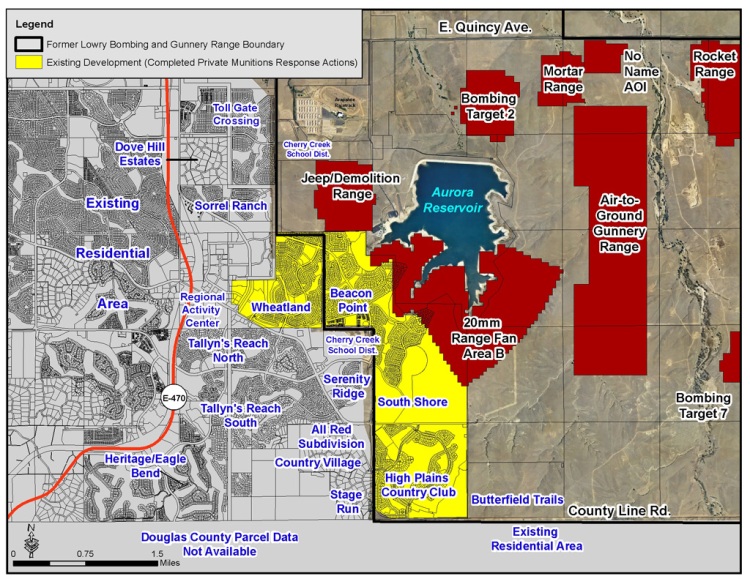 About the Land and Its Uses
About the Land and Its Uses
Information about the Lowry Bombing Range, including present use and future use are at this website: (added note: current oil and gas wells on site are traditional vertical wells, not horizontally fracked wells)
http://www.flbgr.org/landuse/landuse.html
Information about the Colorado State Land Board’s 37 acres of the Lowry Bombing Range Land is at
tp://trustlands.state.co.us/PROJECTS/LOWRYRANGE/Pages/LowryRange.aspx
An article in the Denver Business Journal, by Cathy Proctor, Feb. 18, 2011, describing the fracking being considered for the Lowry Bombing Range Land by the Colorado State Land Board: “Lowry’s Oil Royalties Could Yield Millions”
An article in the Denver Business Journal, by Cathy Proctor, August 29, 2010, describing the oil and gas company frenzy to obtain mineral rights to metro Denver & county Niobrara shale drilling: “Niobrara Fever Hits Metro Counties”
http://www.bizjournals.com/denver/stories/2010/08/30/story1.html
Important Video To Watch
A YouTube interview, with Wes Wilson speaking about fracking at the Lowry Bombing Range, Arapahoe County, Colorado. Wes Wilson, an Environmental Protection Agency whistle-blower, brought to light the dangers of hydraulic fracturing (fracking) to our air and water in 2004.
http://www.youtube.com/user/FrackingColorado
What You Can Do
Voice your opinion to our city, county and state officials by writing letters. They need to hear that citizens are concerned about fracking. Here are addresses of people to contact.
Colorado State Land Board
Melissa Yoder, Lowry Range Project Manager
Colorado State Board of Land Commissioners
1127 Sherman St., Suite 300
Denver, CO 20203-2206
The five State Land Board Commissioners can be reached at the same address and their
names and information can be found at:
http://trustlands.state.co.us/commissioners/pages/commissioners.aspx
Discussion
4 thoughts on “Fracking Aurora”
Trackbacks/Pingbacks
-
Pingback: - May 19, 2012
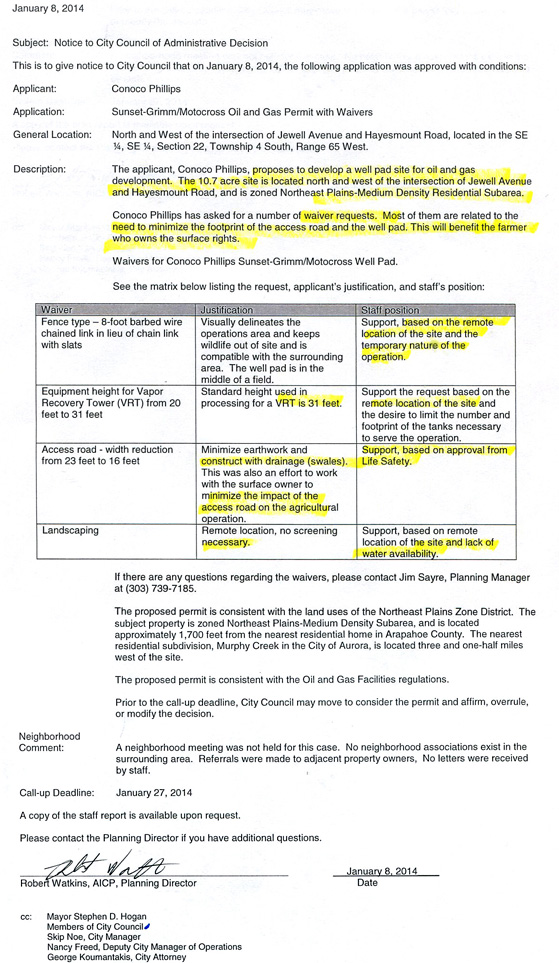
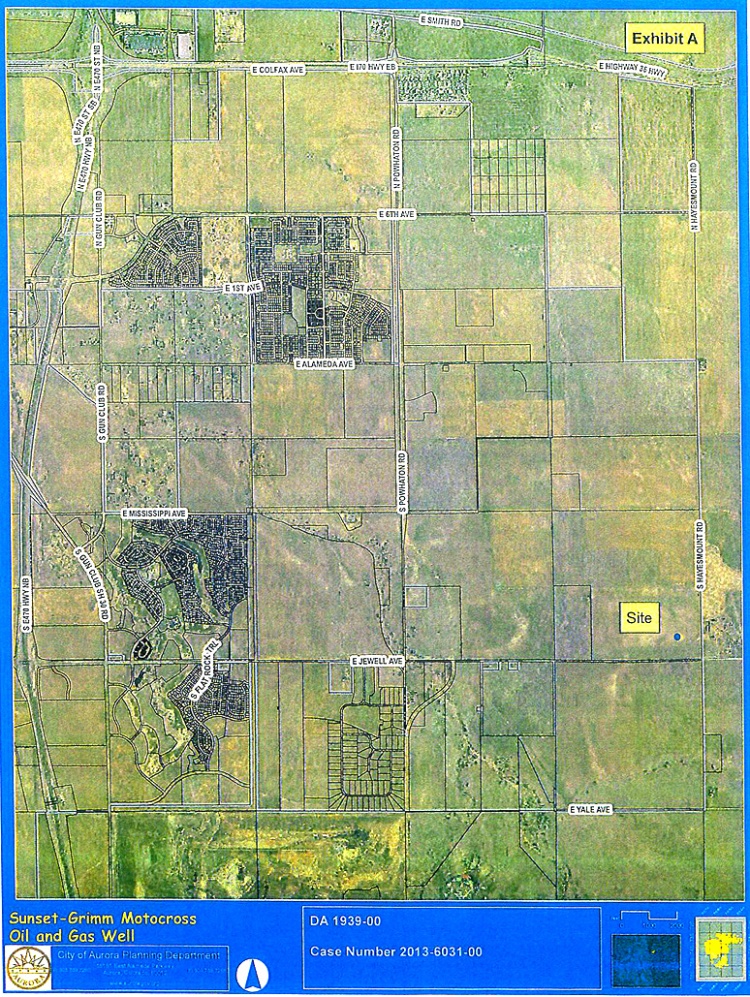
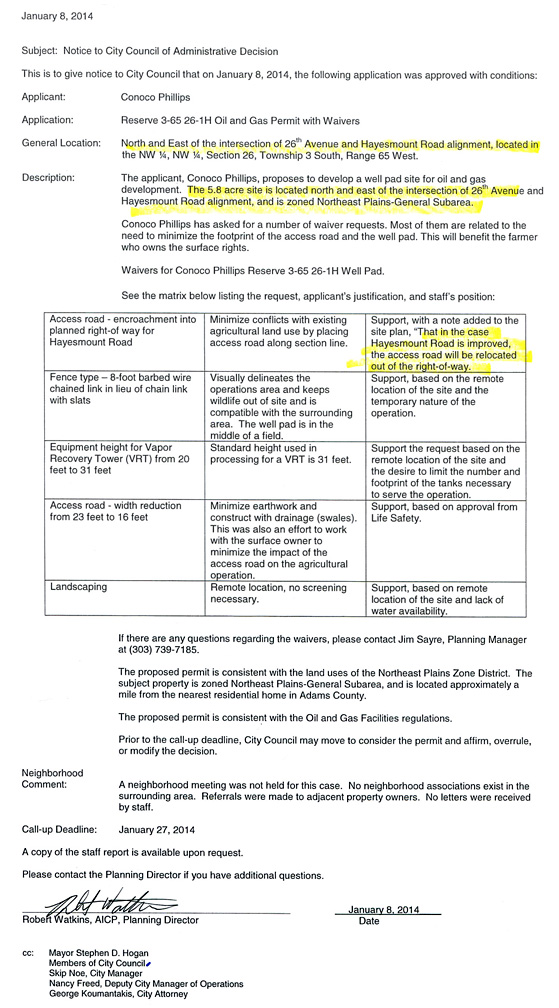
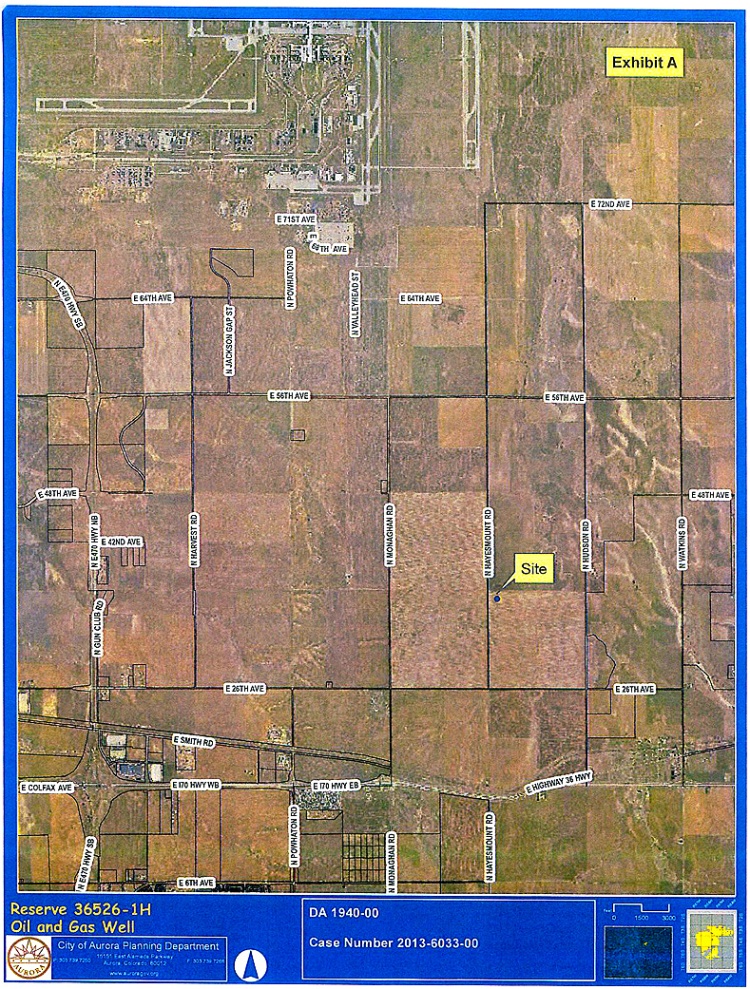
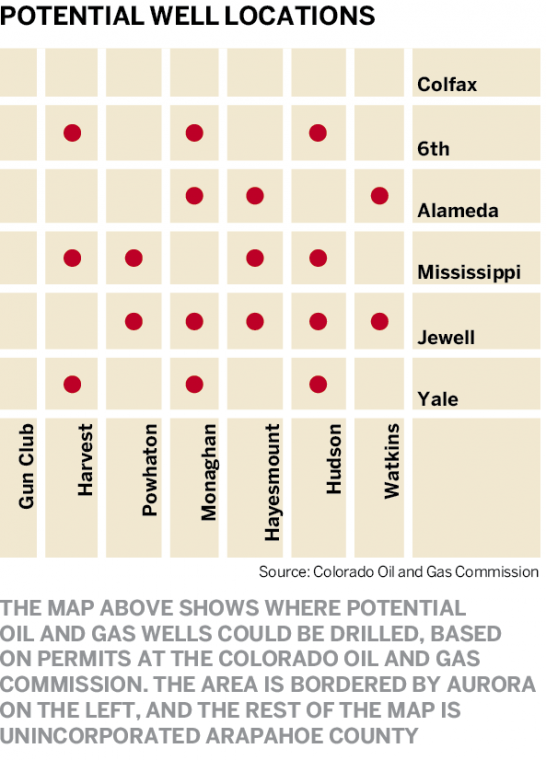
MY FRICKING FRACKING FAIRY TALE
Once upon a time in the South of North America a place called Texas, there were massive deposits of liquefied dinosaur buried deep in the land. Some people came along and said we need that liquefied dinosaur & let’s see what we can do with it and contemporary people became very dependent on the stuff that could be made with it, and the people made a lot of money and were very prosperous and happy living to limits never know before to man, really mind blowing things beating disease, travelling & communicating at unbelievable speeds. It was a time like no other.
Under the earth and in the air trouble was a brewing. Sinkholes, and earthquakes and fires OH MY. The worst came when the oil had been drawn out, and the gas rush hit, why it was stronger than the gold rush and there were a lot more whores. Selling out people’s homes that they loved so they could bring in giant syringes made of metal with power boosters for added pressure and they started pumping the water out of the lakes and mixing it with diesel fuel and other chemicals and injecting it in to the earth to force the natural gas out of the shale. I wonder if the earth hates needles as much as I do.
Before we go on with the story how many of you know the nature of shale? It is a porous rock with many natural fissures (aka cracks) and when it gets wet it expands and then when it dries out not only does it shrink it also becomes very brittle and breaks apart. You can see the crumbly layers of it at the Grand Canyon.
Some people stood up and said we do not want this it is increasing the number of childhood leukemia cases in our area, and some other people said yes but look we made these wonderful medical supplies so we can give you treatment for your terrible illnessThe EPA did studies and said well get back to you with the results in a couple of years, and other companies came and took air samples and said everything is fine. But the greed mongers kept fracking. In fact they fracked so much they had to build giant storage fields as big as 10 football fields. While our story takes place in Texas this was happening worldwide as if the Nazi’s were gassing the whole world all at once. THE HORROR!
So one April in 2011 wildfires broke out across the state of Texas the whole state was on fire except 2 counties, and firemen were killed and other firemen came to help. One of the fires burned one of the storage sites. That place went up in seconds don’t cha know. Meanwhile, various homes were exploding and workers at the frackin sites were blowing up and burning to death. Later maybe someone will come along and find a use for them once the earth has liquefied them, but that’s a whole other story. Back in Texas the earth was a rumbling just some small earthquakes no big deal except for the Comanche Peak Nuclear Power Plant. Just a little Nuclear power Plant on the Brazos, betcha the Real Comanche are going to be pretty pissed that such a deadly thing be named after them. If you ever go take the tour they will tell you how it is built on the most geographically stable areas on the continent, really, and maybe it was but that was before the fracking and the earthquakes in Cleburne, only 25 miles away, as the crow flies.
After the fires came the worse drought on record for many parts of Texas and in the area of the Barnett Shale the already carbon dioxide rich air had new additives like more benzene (aka cancer accelerant, not to worry though we have these fabulous medical supplies) the benzene got in the air through evaporation from all the new frack pond they had built across the land. Why I myself have three of these right here in my little town just a mile away. The people did not feel well, and their happiness was fading, but they didn’t even realize why, not all of them. Then in August at one of the gas compression plants there was a fire and a huge leak that went on for hours, but it was decided that they would not tell the people and the gas Companies had their own police and fire department take care of everything very hush hush and on the down low.
Oh I almost forgot to mention the nuclear power plant was located on top of the Barnett Shale. Wait for it …here it comes they drained all the lakes and people kept moving to Texas to get away for their bad weather, and the infrastructure was really maxed out and the pressure built and the pressure underground built and then one terrible dark day the ground burst and the plant started leaking and it got in the rivers and it got on the people and the white dust from the gypsum mines covered over them from giant wind storms and everywhere you looked where rivers flowing with chalky white bodies so thick you could not even see the water just a river of people. There were explosions of gas everywhere and the earth opened up, and this is for all you Armageddon enthusiasts, and hell, yes hell was created. Those that remained were angered and they sought the people who profited from the fracking and they seized them and said look at the destruction you have caused and they cast them in the fire.
After some time the earth healed its oowwee and it scabbed over and eventually new vegetation started growing, but most of the people were gone because they could not get clean water or food or gas to warm them when the cold came. The End.
In the Words of Alice Cooper…Welcome to my nightmare.
Posted by Does anyone Care | November 9, 2011, 11:09 amAh! I take a little time out from the blogging universe and come back to find that you
have turned awesome?! Wow, times have changed! Keep up the awesome work!
Posted by Lipika Vig | July 29, 2012, 3:35 pmThis is a very informative article, by Michele Swenson, that covers recent fracking news items in Colorado. She covers what people in various communities are doing to raise awareness, and protect public health and our environment. This issue must be addresses on multiple fronts.
Posted by lowryarapahoe | May 20, 2012, 11:23 pm